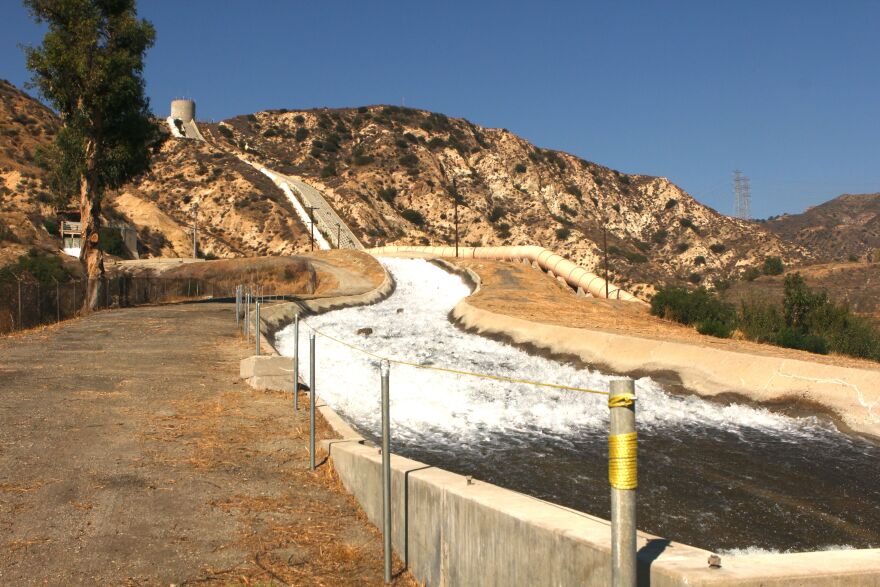With our free press under threat and federal funding for public media gone, your support matters more than ever. Help keep the LAist newsroom strong, become a monthly member or increase your support today .
LADWP to supplier: Take our extra water, no charge

When this winter's record snowpack in the Eastern Sierra melts in the next few months, so much extra water is expected to surge south through the Los Angeles Aqueduct that the Los Angeles Department of Water and Power won't be able to store it all.
So, the LADWP plans to give the water away.
The beneficiary will be the giant water wholesaler the Metropolitan Water District of Southern California. The MWD will receive as much as 200,000 acre feet of excess aqueduct water at no cost, said Brent Yamasaki, its assistant manager for water systems operations. That amount is enough to meet the annual water needs of about 400,000 households.
"We have the system and the flexibility to broadly deliver this water throughout Southern California and that's why they are asking for our help," Yamasaki said.
In turn, MWD will sell the water to utilities and water agencies in several Southern California counties that serve homes and businesses. Some water agencies may buy extra water to inject underground to replenish aquifers depleted by the recent drought.
The water transaction does have some payback to LADWP, according to the agreement between the two agencies. For every three acre feet of water MWD takes, LADWP will receive two acre feet back if they request a return before the end of this year. That ratio shrinks to two-to-one during 2018 and 2019.
L.A. Mayor Eric Garcetti declared a snowmelt emergency last month for the city and communities in Mono, Inyo and Kern counties along the 200-mile-long aqueduct as it deals with as much as 1 million acre-feet of snowmelt water.
The LADWP can channel about half the excess along the aqueduct to its own customers, enough so that it can halt its MWD purchases that in typical years would augment the city's aqueduct-supplied water. An additional one-third of the water can be stored in underground aquifers, recharging groundwater storage.
The city is looking to the MWD to take the remaining extra water. The bonus water could amount to 10 to 15 percent of the MWD's normal water sales volume.
LADWP pipelines are mostly set up to receive water from the MWD because the city is one of its customers. But in rare instances, the water can flow in the other direction, from city pipes to the MWD's. That has happened six times since 1999, said LADWP spokesman Joe Ramallo.
The transfer of L.A. Aqueduct water will occur at two places where the different water systems connect via 5-foot diameter pipes. One location is in Granada Hills near the aqueduct, the other is at Lake Silverwood in the Antelope Valley, Yamasaki said.
The connections were built in the early 1980s to enable the LADWP to feed water into the MWD system during the rare water emergency or system shutdown, he said. They were last used in 2006. The valves were opened briefly and then closed as a test several weeks ago, Yamasaki said. The transfer of L.A. city water to the MWD would begin when the quantities of snowmelt start to increase.
Clarification: This report has been updated to include LADWP receiving future credit for two-thirds of the water it provides to the MWD.
At LAist, we believe in journalism without censorship and the right of a free press to speak truth to those in power. Our hard-hitting watchdog reporting on local government, climate, and the ongoing housing and homelessness crisis is trustworthy, independent and freely accessible to everyone thanks to the support of readers like you.
But the game has changed: Congress voted to eliminate funding for public media across the country. Here at LAist that means a loss of $1.7 million in our budget every year. We want to assure you that despite growing threats to free press and free speech, LAist will remain a voice you know and trust. Speaking frankly, the amount of reader support we receive will help determine how strong of a newsroom we are going forward to cover the important news in our community.
We’re asking you to stand up for independent reporting that will not be silenced. With more individuals like you supporting this public service, we can continue to provide essential coverage for Southern Californians that you can’t find anywhere else. Become a monthly member today to help sustain this mission.
Thank you for your generous support and belief in the value of independent news.

-
Immigration raids have caused some U.S. citizens to carry their passports to the store, to school or to work. But what documents to have on you depends on your citizenship.
-
The historic properties have been sitting vacant for decades and were put on the market as-is, with prices ranging from $750,000 to $1.75 million.
-
Users of the century old Long Beach wooden boardwalk give these suggestions to safely enjoy it.
-
The Newport Beach City Council approved a new artificial surf park that will replace part of an aging golf course.
-
The utility, whose equipment is believed to have sparked the Eaton Fire, says payouts could come as quickly as four months after people submit a claim. But accepting the money means you'll have to forego any lawsuits.
-
The City Council will vote Tuesday on a proposal to study raising the pay for construction workers on apartments with at least 10 units and up to 85 feet high.







